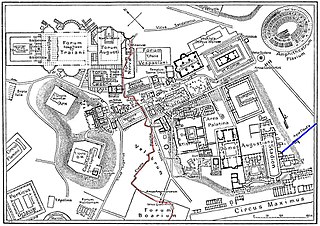
In Ancient Roman architecture, a basilica is a large public building with multiple functions, typically built alongside the town's forum. The basilica was in the Latin West equivalent to a stoa in the Greek East. The building gave its name to the architectural form of the basilica.

Marcus Porcius Cato, also known as Cato the Censor, the Elder and the Wise, was a Roman soldier, senator and historian known for his conservatism and opposition to Hellenization. He was the first to write history in Latin with his Origines. His epithet "Elder" distinguishes him from his equally famous great-grandson Cato the Younger, who opposed Julius Caesar.

The Roman Forum, also known by its Latin name Forum Romanum, is a rectangular forum (plaza) surrounded by the ruins of several important ancient government buildings at the center of the city of Rome. Citizens of the ancient city referred to this space, originally a marketplace, as the Forum Magnum, or simply the Forum.

The Esquiline Hill is one of the Seven Hills of Rome. Its southernmost cusp is the Oppius.
The Caelian Hill is one of the famous seven hills of Rome.

The Cloaca Maxima was one of the world's earliest sewage systems. Constructed in Ancient Rome in order to drain local marshes and remove the waste of one of the world's most populous cities, it carried effluent to the River Tiber, which ran beside the city.

The Basilica Julia was a structure that once stood in the Roman Forum. It was a large, ornate, public building used for meetings and other official business during the Roman Empire. Its ruins have been excavated. What is left from its classical period are mostly foundations, floors, a small back corner wall with a few arches that are part of both the original building and later Imperial reconstructions and a single column from its first building phase.

The Basilica Aemilia was a civil basilica in the Roman Forum, in Rome, Italy. Today only the plan and some rebuilt elements can be seen. The Basilica was 100 meters (328 ft) long and about 30 meters (98 ft) wide. Along the sides were two orders of 16 arches, and it was accessed through one of three entrances.

San Sebastiano fuori le mura, or San Sebastiano ad Catacumbas, is a basilica in Rome, central Italy. Up to the Great Jubilee of 2000, San Sebastiano was one of the Seven Pilgrim Churches of Rome, and many pilgrims still favor the traditional list.

The Temple of Venus Genetrix is a ruined temple in the Forum of Caesar, Rome, dedicated to the Roman goddess Venus Genetrix, the founding goddess of the Julian gens. It was dedicated to the goddess on September 26, 46 BCE by Julius Caesar.
The Temple of Victory is a temple on the Palatine Hill in Rome. It was dedicated to the Roman goddess of Victory.
The Basilica Fulvia was a basilica built in ancient Rome. According to Livy (40.51), the censors M. Aemilius Lepidus and M. Fulvius Nobilior had it built in 179 BC. It may be that there had been a previous building existing on the site from 210 BC which was incorporated. In 78 BC, the consul M. Aemilius Lepidus incorporated the building into the Basilica Aemilia, and it was renamed the Basilica Fulvia et Aemilia or sometimes simply the Basilica.

The Basilica of Saints John and Paul on the Caelian Hill is an ancient basilica church in Rome, located on the Caelian Hill. It was originally built in 398.

The Curia Julia is the third named curia, or senate house, in the ancient city of Rome. It was built in 44 BC, when Julius Caesar replaced Faustus Cornelius Sulla's reconstructed Curia Cornelia, which itself had replaced the Curia Hostilia. Caesar did so to redesign both spaces within the Comitium and the Roman Forum. The alterations within the Comitium reduced the prominence of the Senate and cleared the original space. The work, however, was interrupted by Caesar's assassination at the Theatre of Pompey, where the Senate had been meeting temporarily while the work was completed. The project was eventually finished by Caesar's successor, Augustus Caesar, in 29 BC.

The Basilica of Junius Bassus was a civil basilica on the Esquiline Hill in Rome, on a site now occupied by the Seminario Pontificio di Studi Orientali, in via Napoleone III, 3. It is best known for its examples of opus sectile work.
The Basilica Opimia was one of four Republican-era basilicas in the Roman Forum. The other two were the Basilica Aemilia, the Basilica Porcia, and the Basilica Sempronia. Of the three, only the Basilica Aemilia partially survives.

The Porta Maggiore Basilica is an underground basilica discovered in 1917 near Porta Maggiore in Rome. It is dated to the first century BC. It is believed to have been the meeting place of the neo-Pythagoreans, and is the only historical site that has been associated with the neo-Pythagorean movement. This school of mystical Hellenistic philosophy preached asceticism and was based on the works of Pythagoras and Plato. It was a precursor to the basilicas built during the Christian period, centuries later. It was opened to small groups of visitors in April 2015.
In the Catholic Church, a basilica is a large and important church building designated as a basilica by the Pope and thereby distinguished for ceremonial purposes from other churches. It does not need to be a basilica in the architectural sense. Basilicas are either major basilicas — of which there are four, all in the diocese of Rome — or minor basilicas, of which there were 1,810 worldwide as of 2019.













